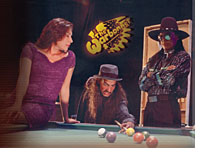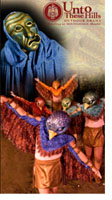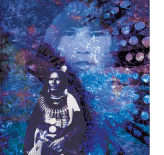Events: 2008

A READING OF FOUR PLAYS BY BRUCE KING
HOOP Theatricals/Project HOOP Presents
Friday, April 25 at 10 a.m.
Evening at the Warbonnet
Whispers from the Other Side
Threads: Ethel Nickle's Little Acre
Wolf in Camp
A noted playwright, screenplay writer, and artist, Bruce King's work has been performed across the United States and in Canada. His plays have been staged primarily in Native American and Canadian Native communities, but also in New York at Cafe La Mama and the Westside MainStage.
Sponsored by HOOP Theatricals/ Project HOOP
Email: hoop@ucla.edu
Website: www.hoop.aisc.ucla.edu
Los Angeles Theatre Center
514 S. Spring St.
Los Angeles, CA 90013
(213) 489-0994
Email: lantonio@latinotheater.com

What's an Indian Woman to Do?
The Los Angeles Theater Center continues its Cultural Reconstruction Series with the lively and insightful one woman show What's an Indian Woman to Do?, starring Cherokee Indian actress, DeLanna Studi. Presented by Project HOOP (Honoring Our Origins and People) and the American Indian Dance Theater, the play is the story of Belle, a half White, half Ojibwe girl who identifies with her Native American Heritage, yet is constantly "culturally upstaged" by her white friend Katrina, and ceremoniously mocked for her modern life and ideas my her traditional reservation bound Auntie, for whom she was named. The one-woman show is based on Marcie Rendon's succinctly titled poem: What's an Indian Woman to Do When White Girls Act More Indian Than Indian Women Do.
The play will be presented at 8 p.m. Thursdays and Fridays and 2 and 8 p.m. Saturdays from June 28 through July 14.

Unto These Hills
Outdoor Drama
When the Western North Carolina Associated Communities (WNCAC) selected its first slate of officers in 1946, it also appointed a Projects Committee to study and present a list of proposals for increasing tourism in the region. The idea of an outdoor drama about the history of the Cherokee Indian, in Cherokee, NC, was an appealing one, and, almost immediately, the Projects Committee began exploring where the theatre would make its home.
By the end of 1947, the committee had narrowed its list to three locations: the old Indian Ball Ground; a ravine above the Fairground; and the site of an old nursery on the mountainside. Hoping to avoid the traffic noise at the first two sites, the committee finally chose the quiet mountainside. The terrain provided a natural bowl with excellent acoustics; it was protected from the wind; and the surrounding vegetation was lush. The site orientation was such that the sun would set behind the audience, and the rising moon would provide a backdrop for the dramatic action. There was also ample space for the 2,800 seats necessary, and a primitive road already climbed the mountainside. Considering the size of the project, a minimum of earthmoving would be necessary.
The creator of the Manteo Waterside Theatre, home of "The Lost Colony," was asked to be the architect, and work began in 1948. From the outset, the emphasis was on achieving harmony between the story and its setting. To help reach this goal, natural, local building materials were used to blend with the surrounding forest.
For more information, please click here.

Wakonda’s Dream
Wakonda’s Dream is about a contemporary Native American family, impacted by the historical events that occurred in Nebraska in 1879 that changed the legal status of American Indians to that of “human beings under the law” for the first time in U.S. history. The opera is the story of a mother, Delores, a father, Justin, and a son, Jason, struggling to find their place as American Indians in contemporary society. Young Jason“sees things, feels things, knows things,” which terrifies his mother. Proud of her Ponca past, Delores keeps the history of their people alive for her son. This only intensifies Jason’s ghostly connection to the long-dead Chief Standing Bear, whose legacy is revealed in a choral rendering of the famous 1879 trial. As Jason grows from childhood to manhood, Standing Bear remains his spiritual guide, while Jason’s dismissal of his Indian birthright leads to tragedy and, ultimately, redemption.
For more information, please click here.

